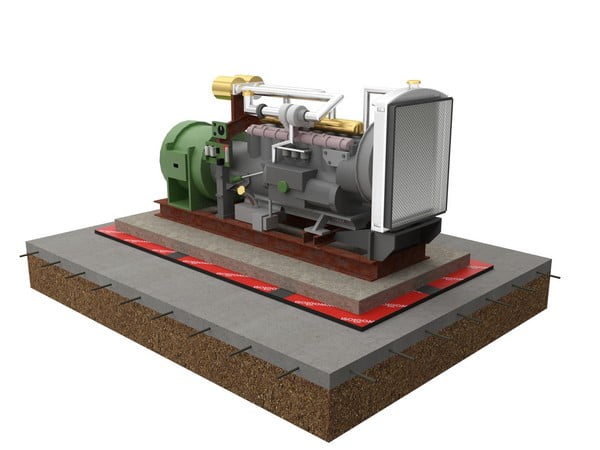

Hard surfaces, such as hardwood and laminate, tend to amplify sounds like footsteps, which can lead to unwanted echo and reverberation. Buildtec Acoustics offers a variety of acoustic underlays to meet different needs, including those designed for underfloor heating systems. Soundproofing Material Products from this Soundproofing Supplier are affective acoustic solutions. Acoustic underlays are compatible with a wide range of flooring materials, including tiles, carpet, and wood. When talking about soundproofing solutions, acoustic underlays are an effective option for reducing noise pollution, improving room acoustics, and creating a quieter and more comfortable living or working environment.
Acoustic underlays help absorb these sounds, contributing to improved room acoustics. Most underlays come in sheet or roll form and can be cut to size with simple tools like a utility knife. This allows consumers to achieve their preferred aesthetics without sacrificing soundproofing performance.
Acoustic underlays are versatile and can be used in a variety of settings, from residential homes to commercial spaces such as offices or retail environments. Acoustic underlays are valuable for renovation projects as well. The installation of acoustic underlays is straightforward and suitable for both professionals and do-it-yourself (DIY) enthusiasts.
Reducing sound transmission class (STC) and impact insulation class (IIC) ratings in a building helps create a more comfortable space, particularly in multi-story buildings where floors are interconnected through walls and joists, making noise control important. These options support sustainability by reducing reliance on virgin materials and lowering overall pollution. They are installed beneath the visible flooring material, meaning that the desired flooring-whether elegant hardwood, practical laminate, or cozy carpet-remains unaltered.
In rooms with underfloor heating, selecting an underlay with low thermal resistance allows heat to transfer efficiently without being blocked by the soundproofing material. They are particularly effective when used with materials like ceramic tiles or floating floors, providing both sound insulation and comfort underfoot. Most underlays come in sheets or rolls and can be cut to size with simple tools like a utility knife. The underlays provide a cushion that helps to reduce the transmission of vibrations and sound through the floor.
Acoustic underlays are also beneficial for renovation projects. Some underlays are certified by Leadership in Energy and Environmental Design (LEED) standards, supporting sustainable building practices. Acoustic underlays do not compromise the aesthetics or design of the finished floor.
Environmental considerations are central to the design of acoustic underlays. In commercial settings, reducing noise pollution creates a more productive and pleasant work environment, enhancing overall efficiency. Acoustic underlays are valuable for renovation projects as well.
Buildtec Acoustics provides underlays with specific properties to address either airborne or impact noise. Reducing sound transmission class (STC) and impact insulation class (IIC) ratings in a building helps create a more comfortable environment, particularly in multi-story buildings where floors are interconnected through walls and joists, making noise control essential. solvent Underlays help to isolate vibrations, preventing them from being transmitted through the building structure and reducing their impact on adjacent rooms or units.
Room within a room
This section does not cite any sources. Please help improve this section by adding citations to reliable sources. Unsourced material may be challenged and removed. (September 2021) (Learn how and when to remove this message)
A room within a room (RWAR) is one method of isolating sound and preventing it from transmitting to the outside world where it may be undesirable.
Most sound transfer from a room to the outside occurs through mechanical means. The vibration passes directly through the brick, woodwork and other solid structural elements. When it meets with an element such as a wall, ceiling, floor or window, which acts as a sounding board, the vibration is amplified and heard in the second space. A mechanical transmission is much faster, more efficient and more readily amplified than an airborne transmission of the same initial strength.
The use of acoustic foam and other absorbent means is less effective against this transmitted vibration. The transmission can be stopped by breaking the connection between the room that contains the noise source and the outside world. This is called acoustic decoupling.
The compatibility with different floor finishes makes acoustic underlays an essential component of modern flooring design, creating a space that is both visually appealing and acoustically comfortable. Whether in a single-family detached home or a semi-detached house, installing acoustic underlay ensures that daily activities do not negatively impact others in the building. The compatibility with different floor finishes makes acoustic underlays an essential component of modern flooring design, creating a space that is both visually appealing and acoustically comfortable. They are installed beneath the visible flooring material, meaning that the desired flooring-whether it is elegant hardwood, practical laminate, or cozy carpet-remains unchanged.
Acoustic underlays are versatile and suitable for use in many settings, from residential homes to commercial spaces such as offices or retail environments. This process involves the transformation of sound energy into heat, which then dissipates harmlessly. This helps enhance communication between occupants by reducing noise interference.
Acoustic underlay is a specialized material that plays a critical role in noise control within residential and commercial spaces. For instance, Tecsound underlays are often used beneath concrete or screed subfloors to add a layer of soundproofing that is effective against vibration and noise. These underlays act as a cushion that minimizes the transmission of vibrations and sound through the floor.
By reducing both airborne and impact noise, these underlays contribute to creating a peaceful environment, whether at home, in the office, or in a commercial setting. When discussing soundproofing options, acoustic underlays offer an efficient means to reduce noise pollution, enhance room acoustics, and create a comfortable environment. In commercial settings, reducing noise pollution creates a more productive and pleasant work environment, enhancing overall efficiency.
Buildtec Acoustics offers underlays made from environmentally friendly materials, such as cork, recycled crumb rubber, and natural wool. Whether the flooring type is laminate, ceramic, or hardwood, Buildtec Acoustics provides underlays specifically designed to complement the chosen material. Some underlays are certified by Leadership in Energy and Environmental Design (LEED) standards, promoting sustainable building practices. The installation of acoustic underlays is straightforward and can be carried out by both professionals and do-it-yourself (DIY) enthusiasts. Acoustic underlays made from polyvinyl chloride (PVC) or cork are ideal choices, as they balance both thermal insulation and soundproofing requirements.
Adhesive or double-sided tape can be used to secure the underlay in place, while ensuring tight seams between pieces to prevent gaps that could impact performance. Whether in a single-family detached home or a semi-detached house, the installation of acoustic underlay ensures that everyday activities do not negatively affect others in the space. With a wide range of materials, including cork, foam, natural rubber, and recycled fibers, Buildtec Acoustics ensures that there is an environmentally friendly and efficient product to meet every need. In conclusion, acoustic underlays from Buildtec Acoustics offer an effective solution for soundproofing floors, enhancing room acoustics, and improving overall comfort.
Underlays help to isolate vibrations, preventing them from being transmitted through the building structure and reducing the impact on adjacent rooms or units. The use of recycled fibers and materials encourages recycling while reducing the environmental footprint of soundproofing installations. Buildtec Acoustics offers underlays made from environmentally friendly materials, such as cork, recycled crumb rubber, and natural wool. The use of underlays extends to various applications, including renovation projects.
The materials used in acoustic underlays, such as foam, cork, and natural rubber, contribute significantly to reducing vibrations and sound transmission. By utilizing high-density materials like crumb rubber and cork, acoustic underlays effectively control noise, reducing its impact on people in adjacent rooms or units. Acoustic underlays are also beneficial for renovation projects. These underlays not only help reduce noise but also enhance thermal conductivity, supporting efficient heat transfer within the room.

The primary function of acoustic underlays is to manage both impact noise and airborne sound. This allows consumers to achieve their preferred aesthetics without sacrificing soundproofing performance.
Environmental considerations are central to the design of acoustic underlays.
The choice of acoustic underlay depends on the type of noise to be managed.
Buildtec Acoustics offers underlays made from environmentally friendly materials, such as cork, recycled crumb rubber, and natural wool.


In residential buildings, whether in a semi-detached house or an apartment, acoustic underlays are commonly installed under laminate flooring, hardwood, or carpets to reduce noise transmission through walls, ceilings, and stairs. During renovations, installing acoustic underlays can significantly improve the acoustic properties of existing floors, whether in residential or commercial settings.
This allows consumers to achieve their desired aesthetics without sacrificing soundproofing performance. Airborne noise, such as music or conversations, can be reduced by choosing underlays with higher sound transmission class ratings. Buildtec Acoustics offers a variety of acoustic underlays to meet different needs, including those designed for underfloor heating systems. Acoustic Underlay
Acoustic underlays do not compromise the aesthetics or design of the finished floor. Additionally, these materials provide excellent thermal insulation, enhancing the thermal resistance of the room while managing noise.
Buildtec Acoustics provides underlays with specific properties to handle either airborne or impact noise. These options support sustainability by reducing reliance on virgin materials and lowering overall pollution.
The primary function of acoustic underlays is to address both impact noise and airborne sound. Underlays help to isolate vibrations, preventing them from being transmitted through the building structure and reducing the impact on adjacent rooms or units.